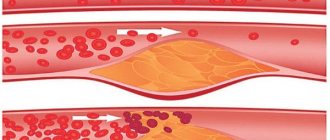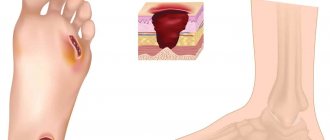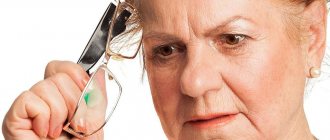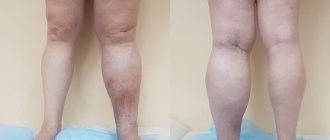The outside of the human eye is covered with a thin transparent tissue - the conjunctiva. This is the mucous membrane, which contains many thin blood vessels. If the vessels dilate for any reason, redness of the eye may occur, which is noticeable from the outside. But it also happens that they not only expand, but burst.
Find your nearest optical store
When blood enters the space between the conjunctiva and the sclera (the white layer of the eye), from the outside it looks as if the eye is completely or partially filled with blood. This makes an intimidating impression. However, such hemorrhage itself does not cause pain or visual impairment. A person may not feel anything at all and continue to lead a normal life, doing everyday activities, until others tell him what his eyes look like, or until he looks at himself in the mirror. However, a burst vessel can cause pain. In this case, you should definitely visit a doctor
.
A red spot in the eye due to pressure may take some time to resolve. But even if such a hemorrhage does not entail any health consequences, it is still unpleasant. What if you need to speak in front of an audience, go on a romantic date, or meet with business partners? It is not surprising that many people are concerned about the question: if a vessel in the eye bursts, what drops will help?
Causes of broken capillaries in the eyes
Below we will present and consider in detail the most common causes of ruptured capillaries in the eyes.
Arterial hypertension
The main reason why blood vessels burst is high blood pressure. Most often this occurs in those who have hypertension complicated by a hypertensive crisis. The brain, liver, heart and eyes are most affected by this disease.
What is a hypertensive crisis? It is a sudden increase in blood pressure to extremely high numbers, determined for each individual. That is, for some it can begin already at a pressure of 140/90 millimeters of mercury, while for others only at 200/100 millimeters of mercury. In this case, the vessels located inside the eyeball lose their elasticity and rupture, as they cannot cope with the increased blood flow.
Great physical activity
If you engage in active physical labor for a long time, there is a high probability of vascular rupture. During heavy lifting or active sports, blood pressure rises, which, as in the case of hypertension, causes capillaries to burst.
Eyeball injuries
The reason for the appearance of burst vessels may be a bruise or blow to the eyeball. Hemorrhage is also common in cases of clinical intervention, such as lens replacement surgery.
Diabetes
This disease is characterized not only by a deficiency of insulin in the blood and an increase in glucose, but also by damage to capillary vessels. This can be explained by the fact that an excess of glucose has a negative effect on the walls of blood vessels, as a result of which they become thinner in some areas and thicken in other areas. This process leads to a decrease in the elasticity of blood vessels, which also affects their strength.
Eye fatigue
Eye fatigue has become a common disease for every office worker. Increased pressure on the eyes is observed in those who spend a lot of time at the computer or reading, especially texts in small print. Also, poor lighting and long hours of work without rest breaks can lead to rupture of capillaries (important for students during the exam session), since the eyes are constantly under tension, there is a constant flow of blood to the eyeballs, which leads to rupture of the capillaries.
Sudden change in weather conditions
Those people who can be classified as weather-dependent often suffer from ruptured capillaries in the eyes. This is due to a sharp increase or decrease in blood pressure.
Inflammation of the cornea
Inflammatory processes in the eyes often lead to redness. Inflammation can be triggered by mechanical trauma to the retina, allergies, mechanical or thermal burns, or foreign bodies entering the eye. Also, the cause of inflammation of the cornea can be a disregard for eye hygiene. Symptoms of this disease, in addition to rupture of capillaries, are lacrimation and intolerance to bright light.
Read: Hemorrhage under the conjunctiva is called subconjunctival hemorrhage.
Conjunctivitis
The reasons for the appearance of this disease are the same as for inflammatory processes in the cornea. Often they occur simultaneously. Symptoms include itching, burning, discharge from the palpebral fissure, and rupture of blood vessels.
Neoplasms of the eyeball
The appearance of a tumor on the eyeball will invariably lead to deformation of the blood vessels of the eye, making them susceptible to rupture.
Lack of vitamins in the diet
If you do not consume enough vitamins C and P, this can cause the vascular wall to thin, so that it becomes easily vulnerable and bursts.
Fragility of vascular walls
The condition of blood vessels is affected by medications and eye diseases, which can cause increased fragility of blood vessels.
Head injuries
In the case of traumatic brain injuries, there is often a disruption in the blood circulation in the brain and the outflow of cerebrospinal fluid, which can cause an increase in blood pressure in the vessels of the eyes.
Overheat
If you like to visit a bathhouse or sauna, then burst capillaries may be a sign that you have stayed there too long. If this happens rarely, you have nothing to worry about. However, if you experience regular symptoms, you need to stop going to these places and immediately consult a doctor.
Also, rupture of the vessel can be caused by sunstroke or being in a room with too high a temperature.
Improper wearing of contact lenses
Many of those who use contact lenses neglect their care. To prevent eye bleeding, change your lenses regularly, remove them at night, and do not leave them on if you feel discomfort. Rubbing the eyeball not only contributes to the appearance of burst blood vessels, but also the development of a number of eye diseases.
Alcohol and drugs
Excessive alcohol and drug use leads to a sharp increase in blood pressure, which causes burst capillaries.
Poor quality mascara or eye shadow
Bad cosmetics can cause hemorrhage. Always check the expiration dates of cosmetic products, and also, if you have sensitive eyes, buy only those mascara and shadows that have been approved by ophthalmologists.
Tears
While sobbing, a person involuntarily begins to rub his eyes, which leads to damage to the capillaries. Tears, which contain salt, irritate the damaged areas even more, so a person instantly becomes inflamed.
How to instill drops and carry out treatment: general recommendations
- Before the procedure, you should always wash your hands thoroughly, preferably using bactericidal soap.
- The drugs used must only have a current expiration date. Expired drops may not cause any harm, although they will not have any effect, but may have a negative effect.
- A new and newly opened bottle must be immediately inspected for possible damage to the tip. It should not have nicks or burrs. Although touching the tip directly to the eye during instillation is strictly not recommended, this can happen accidentally and such defective dropper bottles can cause injury.
- Contrary to popular belief, it is not necessary to instill the product while lying down. Moreover, there is simply nowhere to lie down at work or school. You can perform the procedure while sitting, but you must tilt your head as far back as possible.
- Before instillation, the eyelid of the eye being treated must be pulled back with the thumb and index finger of your free hand. Then you need to bring the bottle of medicine at a distance of 1-1.5 centimeters from the eyeball and lightly press on the body of the container.
- Between instillation of different medications, it is necessary to maintain a time interval of 20-30 minutes.
Symptoms
This pathology has one pronounced sign - a reddened eye with a bloody spot on it. It can be very small and barely noticeable if only one capillary has burst, or it can cover the entire front part of the eyeball if there are several vessels that have burst. It is worth noting that redness can only be observed if the torn vessel is located on the front visible part of the eye, but it can also be located behind. In this case, you will feel a slight heaviness in your eyes.
Features of the drugs
Medicines are not always able to completely eliminate hemorrhage. They are effective for isolated capillary damage caused by overvoltage or high pressure.
With injuries, the bleeding is more extensive. There are several types of pathology:
- hyphema of the eye is an outpouring of blood into the anterior chamber, just behind the cornea;
- hemophthalmos - soaking of the sclera and vitreous body with blood;
- damage to retinal vessels and accumulation of blood there.
The most dangerous type of hemophthalmos is retinal hemorrhage. In the absence of emergency assistance, a person develops blindness.
What are the types of hemorrhages in the eye?
Experts divide hemorrhages in the eyes into several categories, depending on their location. Next we will look at each type in detail.
Retinal capillary rupture
This type of hemorrhage can lead to complete loss of vision. The retina, which is part of the eyeball, contains receptors through which visual perception occurs. That is why a burst capillary disables some important receptors. Patients who experience this type of hemorrhage may complain of the appearance of floaters and blind spots, as well as sharply decreased clarity of vision.
Rupture of orbital vessels
With this type of hemorrhage, blood cells penetrate into the fat cell, which is located behind the eyeball. Symptoms of this pathology include swelling, bruising under the eye, protrusion of the eyeball from the socket, pain during movement of the eyeball.
Rupture of blood vessels in the vitreous body
Thanks to the vitreous body, light rays pass through and hit the retina. In case of hemorrhage, the transparency (transparency) of the vitreous body is impaired, which manifests itself in the form of a sharp drop in the quality of vision.
Rupture of blood vessels in the anterior chamber
The most common causes of this type of hemorrhage are trauma and glaucoma. A characteristic feature is a hematoma located in the lower part of the eyeball.
Rupture of a vessel into the sclera or conjunctiva
This type of hemorrhage in the eye is the most common. It leads to redness of the whites of the eyes, as well as hyperemia of the conjunctival membrane on the upper and lower eyelids. The consequences of this disease can include photophobia, the feeling that there is something foreign in your eye, watery eyes, dry eyeballs, and blurred vision.
Our services in ophthalmology
The administration of CELT JSC regularly updates the price list posted on the clinic’s website. However, in order to avoid possible misunderstandings, we ask you to clarify the cost of services by phone: +7
| Service name | Price in rubles |
| Appointment with an ophthalmologist (primary) | 3 900 |
| Comprehensive OCT examination of the retina (one eye) | 3 500 |
| Ultrasound scanning of the anterior segment of the eye | 1 000 |
| Revision of the vitreous cavity | 44 000 — 70 000 |
All services
Make an appointment through the application or by calling +7 +7 We work every day:
- Monday—Friday: 8.00—20.00
- Saturday: 8.00–18.00
- Sunday is a day off
The nearest metro and MCC stations to the clinic:
- Highway of Enthusiasts or Perovo
- Partisan
- Enthusiast Highway
Driving directions
What to do if a vessel in the eye bursts?
If you notice that a vessel in your eye has burst, you should consult a doctor. Only a professional ophthalmologist will be able to give you an accurate diagnosis and prescribe treatment that will help you completely cope with the problem.
In case of injury to the eyeball, you should consult a doctor immediately!
Prescribing treatment is not a mandatory procedure, since in some cases (overload, sports activity, overheating) the redness will go away on its own within a couple of days.
List of the best drops for hemorrhage
Considering the cause of such unpleasant symptoms, the doctor prescribes certain ophthalmic solutions in the form of drops. It is worth considering that they can only be used after a doctor’s prescription and follow the recommendations in the instructions. If adverse reactions develop, you should stop treatment and consult an ophthalmologist.
Emoxipin
The active ingredient of this medicine is methylethylpyridinol. Therefore, the drops have such a pronounced medicinal effect:
Non-surgical eye treatment in 1 month.
- produce an antioxidant effect;
- help strengthen the walls of blood vessels;
- influence the normalization of blood clotting;
- reduce the risk of blood clots.
When using several ophthalmic drugs, the interval between them should be 10-15 minutes. These drops are instilled last.
Taufon
In most cases, they are prescribed to eliminate the consequences that arose after a blow. Sometimes Taufon can cause an allergic reaction. Instill 1-2 drops 3 times a day. The course of drug therapy is 30 days.
Vixipin
Standard dosage: 1 pot 4 times a day. Treatment usually lasts 30 days, but in some cases it can be extended to 6 months.
Diclofenac
Interaction with drugs based on acetylsalicylic acid is prohibited. Use Diclofenac 4 times a day, 1 drop. Treatment lasts 2 weeks.
Hyphenation
Promotes regeneration of mucous membranes and tissues. You can instill Defislez 8 times, 2 drops each. At the same time, maintain a certain time interval between instillations.
Treatment
Only an ophthalmologist can prescribe treatment. Regular eye drops for several days are usually sufficient to relieve inflammation. For conjunctivitis, it is necessary to use drops that contain an antibiotic. In other cases, using only moisturizers may be sufficient.
Remember that burst capillaries can be a harbinger of other, much more serious diseases.
After a detailed examination and diagnosis of the disease, the doctor should prescribe you a course of therapy, which will be aimed at eliminating the causes of redness of the eyes.
Prevention
The appearance of burst blood vessels can be prevented by following a number of recommendations. How can you prevent the occurrence of broken capillaries?
- First of all, take a closer look at your diet. Add more foods containing ascorbic acid and rutin to it. They are found in many vegetables and fruits, for example, oranges, tangerines, spinach, lettuce, and bell peppers.
- Reduce the amount of physical activity, do not carry heavy objects, and do not be excessively zealous in sports activities.
- If you work a lot with the computer and documents (especially with small print), then give your eyes a break every couple of minutes, and also do a special warm-up.
As a warm-up, you can use the following exercise: look into the distance, and then look at the tip of your nose. Repeat this at least fifteen times.
Adviсe
- Do not go to the bathhouse or sauna too often, as heat and high humidity can cause hemorrhage. By the way, you need to be especially careful in public baths so as not to catch infections there.
- Do not delay treatment of colds. At the first signs of illness, start taking antiviral medications, and also take vitamin C in large quantities, which will help protect blood vessels from destruction.
Vitamin C strengthens the walls of blood vessels, making them more elastic. He is also an active participant in hematopoiesis.
- Protect your eyes with goggles during windy weather and wash them immediately when you return home.
- If you have diseases of the endocrine system, as well as hypertension, then take all medications prescribed to you in a timely manner. In this case, symptoms, including bleeding in the eyes, will not have a chance to develop.
- Try to get a good night's sleep, this will not only give you strength, but also eliminate the appearance of bloody spots on your eyes.
- If you have air conditioning in your home, install humidifiers to prevent your eyes from drying out.
- If you receive a mechanical injury, immediately consult a doctor for advice. Some injuries require prompt medical professional help. Fulfilling this condition will help preserve your vision.
- Hemorrhage caused by bacterial conjunctivitis requires special treatment with antibacterial and anti-inflammatory drops. This will help prevent red spots from appearing.
Prevention
With frequent episodes of damage to the eye vessels, you need to pay attention to a nutritious diet enriched with vitamins. You should get rid of bad habits: smoking, alcohol and coffee abuse. It is important to maintain the correct rest and wakefulness regime. Sleep should last at least 8–9 hours a day.
If possible, you should minimize the time spent in front of the TV or computer. When working with these devices, you need to use protective glasses and periodically do exercises from a complex of gymnastics for vision. Be sure to give your body regular moderate physical activity.
Thus, in most cases, a burst eye vessel does not pose any danger to humans, and the situation resolves within a few days or 1–2 weeks. But if these cases often recur, you should definitely undergo an examination by an ophthalmologist and related specialists.
Popular eye drops
Manufacturers offer a huge number of eye drops designed to relieve redness if a vessel in the eye has burst. Below we will look at the most popular of them.
- Visine. Used to relieve redness from the eyes. The mechanism of its action is as follows. Due to the components in its composition, similar in chemical composition to natural human tears, it makes the removal of eye hyperemia faster and also promotes the resorption of hemorrhage. It has a moisturizing effect, which is especially important for people who constantly wear lenses. The product should be instilled into the outer corner of the eye several times a day.
- Emoxipin. These drops were developed specifically to combat the consequences of burst blood vessels in the eye. A clear or slightly yellowish solution should be instilled three times a day until the redness completely leaves you.
- Hyphenation. These drops are necessary to prevent dry eye syndrome, which can cause broken capillaries. Its action is similar to Visine.
- Taufon. This drug is usually recommended for patients with glaucoma. Its goal is to quickly resolve hemorrhages in the eyes. Thanks to its properties, it quickly relieves redness. It should be used every twelve hours, two drops in each eye.
List
Unfortunately, today there are no effective drugs that can combat ocular hemorrhage.
For mild lesions, the doctor may recommend complete rest and the use of certain eye drops that have a general strengthening and health-improving value. These medications stimulate metabolism in damaged tissues and their regeneration, thus promoting their restoration and renewal. Such funds include:
Eye drops Potassium iodide 3%. The main active ingredient is potassium iodide, which has antiatherosclerotic and antimicrobial effects. One of the main drugs used in the treatment of damaged eye vessels. In addition to the antiseptic effect, it promotes the resorption of hemorrhages and has antifungal activity. The drug is not prescribed to patients with impaired thyroid function, with a diagnosis of nephritis or nephrosis, with certain skin lesions, during pregnancy and lactation, and newborn children;
Instructions for use of Potassium Iodide eye drops can be found here.
Emoprox 1%. The main active ingredient is methylethylpyridinol hydrochloride, which has a number of medicinal properties: angioprotective (vasodilator), antiplatelet (prevents the formation of blood clots), antihypoxic (increases resistance to hypoxia), antioxidant (suppresses oxidation). Contraindications include individual intolerance, as well as periods of pregnancy and lactation;
Emoxipin drops 1%. An analogue of Emoprox, with the same active ingredient. Stimulates the resorption of hemorrhages, helps strengthen vascular walls, and improves rheological parameters of blood. The list of contraindications is the same as that of the analogue;
Diclofenac drops 0.1%. The main active ingredient is diclofenac sodium, which has analgesic and anti-inflammatory effects. Used as part of complex therapy for penetrating or blunt eye injuries. In case of hypersensitivity to the components of the drug and other NSAIDs, treatment with Diclofenac is not carried out, as well as with its analogues: Diclof, Naklof;
Taufon 4%. The active substance is taurine, a sulfur-containing amino acid formed in the body during the conversion of cysteine. It is a stimulator of regenerative and reparative processes in case of injuries, restoration and normalization of metabolism
The only contraindication is individual intolerance; use with caution is recommended during pregnancy and lactation, as well as for children under 18 years of age; You can learn about the use of Taufon eye drops in the article.
Hyphenation. The main active ingredient is hydroxypropyl methylcellulose, which provides high viscosity to the medicinal product, as a result of which the drug covers the surface of the eyeball with a film that lubricates and softens the cornea
According to the instructions of Defislez, the consequence of using the drops is the complete restoration of eye tissue within 2-3 weeks. Significant improvement is achieved already on days 3-5;
Visine 0.05%. The drug belongs to the group of alpha-adrenergic agonists and is designed to eliminate eye irritations of various nature: physical, chemical, allergenic. Contraindications to the use of the drug are hypersensitivity to its components, corneal dystrophy, angle-closure glaucoma, children under 2 years of age.
Signs of what diseases
If you notice that you often have bloody spots on your eyes, then this is a serious reason to consult a doctor and conduct examinations for possible diseases.
Keratitis
Keratitis manifests itself in the form of redness of the eyes, increased tearing, and clouding of the cornea. The causes of this disease are allergies, thermal burns, foreign bodies, viruses or fungi. Rupture of capillaries indicates that your body is affected by this disease. To treat it, you need to start taking antiviral and antifungal drugs. As soon as you notice the first symptoms, consult a doctor immediately to avoid consequences in the form of damage to the cornea of the eye.
Conjunctivitis
Conjunctivitis affects the thin transparent film of the eye, thereby causing eye irritation and bursting of capillaries. The causes of its occurrence may be vitamin deficiency, various infections, or the consequences of an allergic reaction. There is a burning sensation in the eyes, but the most characteristic sign is bloody spots on the eyes. The disease can have several forms, including allergic, viral and bacterial. You can become infected with conjunctivitis through airborne droplets. Treatment occurs with medications.
Avitaminosis
Vitamin deficiency, if not eliminated in time, can develop into a serious illness. One of the signs that gives it away is burst capillaries. First of all, for treatment you need to go to a clinic, and also change your diet to saturate it with the necessary vitamins and minerals.
Injuries
Some head injuries go virtually unnoticed, such as minor concussions from a fall from a bicycle, skate or skateboard. However, they have a strong negative impact on human health. Broken capillaries may indicate the presence of internal trauma. If constant fatigue, insomnia and nausea are added to this, you should immediately consult a doctor.
Hypertensive crisis
The appearance of a hypertensive crisis is always unexpected, but broken capillaries in the eyes can indicate it. It is accompanied by a sharp increase in blood pressure, which is very dangerous for humans. There may be a risk of a number of complications. These include stroke, myocardial infarction, and aortic dissection.
Glaucoma
Glaucoma is a disease caused by constant increased pressure inside the eyeball. Therefore, it is not surprising that its characteristic feature is constant redness of the eyes due to burst capillaries. It can lead to complete loss of vision. The disease belongs to the category of long-term with periodic outbreaks of exacerbations. The consequences of crises should be stopped within two to three hours, otherwise this may cause the death of the optic nerve.
Coagulopathy
Another disease that may indicate constant redness of the eyes is coagulopathy. It occurs as a result of an overdose of drugs whose purpose is to thin the blood. They are mainly taken by people with heart disease and arrhythmia, as well as those who must take these medications as a preventive measure for thrombosis.
How do strengthening eye drops work?
When blood vessels are weakened, blood circulation is disrupted and, accordingly, the flow of oxygen to the tissues of the eyes is disrupted. Metabolic processes deteriorate, the quality of vision decreases. As a result, the capillaries weaken even more and, as soon as they become overfilled with blood, they begin to burst, and visible hemorrhages appear on the whites of the eyes. The active components of medicinal liquids help nourish all parts of the visual organs: lens, optic nerve, retina. They help strengthen damaged blood vessels and restore normal blood circulation. This result is achieved with the help of vitamins and minerals that are included in ophthalmic preparations in this category.
Broken blood vessels in the eye in children
It is normal for newborns to have broken capillaries immediately after birth. According to statistics, this happens approximately once in five cases of natural childbirth. And if additional stimulation is used during labor, then hemorrhage in the eyes can occur in almost fifty percent of cases.
Treatment of blood vessels in the eyes with special methods at this age does not require special methods. They disappear on their own within two to three weeks.
In teenagers and schoolchildren, the causes of blood spots on the eyes are similar to the symptoms of adults. If you notice that your child is bleeding in the eyes on a regular basis, then this is a reason to immediately consult a doctor. This symptom may be a sign of the presence of diseases associated with brain activity. It can also signal serious overwork and high stress levels. You should monitor how much time your child spends on computers and under what conditions he does his homework.
What to do
Therapy is not always required, especially if the cause of the problem is harmless (overwork or a sudden change in weather).
Having discovered a damaged joint, it is necessary to observe it for a week. If this happened for the first time, the etiology should be clarified. If the patient knows what caused the damage to the tubular formations, the following measures can be taken:
- Prepare a weak brew of tea, moisten a cotton pad and apply to the eyelid for 10 minutes.
- Apply a cool compress before going to bed. Do not use ice, it can cause colds in your eyes.
- Mix 0.5 tsp. chamomile, linden and mint leaves. Pour 150 ml of water, leave for 20 minutes. Use the medicinal solution for baths.
- Alternately apply compresses of cold and hot water.
These drugs are used for bursting joints in children and adults.
Classification of eye injuries
In ophthalmology, it is customary to distinguish types of eye injuries according to their severity:
- Lightweight, not affecting vision function;
- Moderate, leading to a short-term decrease in vision function;
- Severe, leading to a sustainable decrease in visual functions;
- Particularly severe, leading to loss of vision or the entire eye.
Any type of injury can be caused by a simple blow caused by a hand or some other object. And it is not at all necessary that the blow will be intentional.
Harmless hemorrhage
If the eye turns red as a result of an injury, this does not mean that it needs to be treated immediately. Often, it only looks terrible, requiring seemingly emergency surgical intervention. However, it is most likely a benign subconjunctival hemorrhage that does not require medical treatment. True, a doctor should still determine this, and he will also advise how to quickly get rid of a cosmetic defect if there are no other symptoms or complaints about the state of health.











